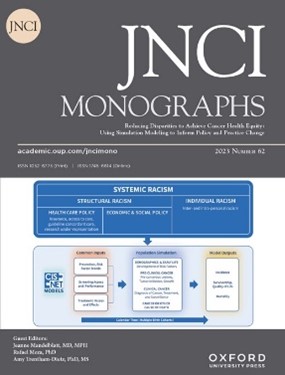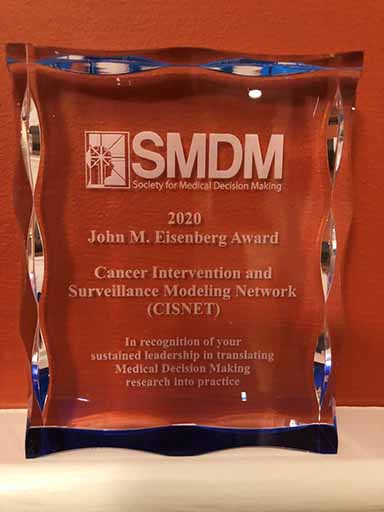Highlights
CISNET models help quantify the impact of cancer control efforts from 1975 to 2045
CISNET investigators, in collaboration with Drs. Goddard and Castle, the directors of DCCPS and DCP, quantified the impact of prevention, screening, and treatment on cancer deaths averted from 1975-2020 and projected the impact of prevention and screening on deaths averted and life years gained from 2021-2045.
Dr. Goddard spoke about CISNET and this work on a recent HealthCast podcast. The modeling showed, 5.94 million deaths were averted from five major cancers (breast, prostate, colorectal, lung, and cervical) between 1975 and 2020. Of these, prevention and screening interventions accounted for 4.75 million, or 80%, of the averted deaths. The investigators projected that over the next 25 years, realistic gains from tobacco control can contribute 0.4 -17 million additional life-years gained per intervention, and 8.4 million additional life-years gained from improving uptake of screening programs over the lifetime of 25 annual cohorts. The papers were also highlighted in an NIH Research Matters blog.
CISNET modeling quantifies the contributions of cancer risk, screening, tumor features, and treatment in mortality for 5 cancers
 Published in JNCI Monographs
Published in JNCI Monographs, analyses by CISNET researchers quantified the contributions of different points along the cancer control continuum on differences in cancer mortality rates for female breast, cervical, lung, prostate, and colorectal cancers between the overall U.S. and Black populations. Differences by cancer site highlight the most important “leverage” points along the continuum for interventions that would have the potential to make significant inroads for improving cancer outcomes. For example, differences in lung cancer are largely driven by cancer risk (smoking patterns), while for prostate cancer tumor features, cancer risk, and treatment contribute about equally. This body of research illustrates how CISNET population-based simulation modeling may be applied to tackle critical public health issues.
CISNET multi-cancer site analysis highlighted the potential role of increased screening uptake in reducing cancer deaths and reaching key milestones for cancer control
A recent CISNET analysis estimated that a 10 percentage point increase in uptake of screening strategies recommended by the US Preventive Services Task Force could prevent 1,010 deaths from lung cancer, 11,070 deaths from colorectal cancer, 1,790 deaths from breast cancer, and 1,710 deaths from cervical cancer over the lifetimes of eligible US residents at the recommended age to begin screening in 2021. Increased screening uptake was also estimated yield additional complications and false-positive tests that result in unnecessary follow-up tests and procedures. Compared with a proxy for the expected lifetime number of deaths from these cancers if current trends in screening and treatment were to continue, a 10 percentage point increase in uptake of lung, colorectal, breast, and cervical cancer screening was estimated to result in a 1% reduction in lung cancer deaths, a 21% reduction in colorectal cancer deaths, a 4% reduction in female breast cancer deaths, and a 40% reduction in cervical cancer deaths. NCI Cancer Currents Blog interviewed Dr. Amy Knudsen, the lead author of the article to further discuss the findings, and the implications for the role of cancer screening in reducing cancer mortality.
CISNET Wins SMDM Eisenberg Award

CISNET has been awarded the 2020 Society for Medical Decision Making (SMDM)’s John M. Eisenberg Award for Practical Application of Medical Decision Making Research. This award recognizes an individual or organization that has demonstrated sustained leadership in translating medical decision making research into practice, and that has taken exceptional steps to communicate the principles and/or substantive findings of medical decision making research to the cancer community including to clinical decision makers and the general public.